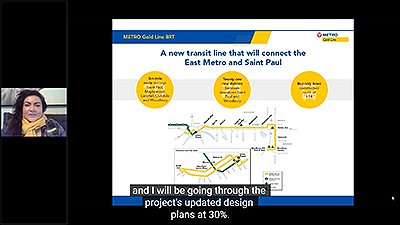Engagement in the time of COVID-19
August 2020
 Community voices, public input, and conversations with elected leaders and people in their neighborhoods provide essential information to guide the decisions the Met Council makes. Whether we’re working on a bus rapid transit line, repairing regional sewer pipes, expanding parks and trails, or supporting the development of affordable housing, we have to understand how our decisions affect each person who lives in the region. Projects without that feedback leave future generations wondering what the builders were thinking.
Community voices, public input, and conversations with elected leaders and people in their neighborhoods provide essential information to guide the decisions the Met Council makes. Whether we’re working on a bus rapid transit line, repairing regional sewer pipes, expanding parks and trails, or supporting the development of affordable housing, we have to understand how our decisions affect each person who lives in the region. Projects without that feedback leave future generations wondering what the builders were thinking.
While the COVID-19 pandemic has dulled one of our best tools – the ability to go out into neighborhoods and communities to meet with people where they live – we have not stopped our work to engage the public. I’m proud of the work all of the Met Council’s divisions are continuing to do to maintain the ongoing regional discussion.
Work on our transit projects hasn’t skipped a beat. Construction on the Southwest light rail project is continuing, with the project ensuring that neighborhoods and businesses are kept up to date on the ongoing construction. The design work on the METRO Gold Line bus rapid transit project moves ahead as project planners hold online town hall meetings so people may view and comment on the plans, now that 60% of the design is completed. Metro Transit’s Network Next project is continuing to engage riders to find out how to best adapt the region’s bus service to the changing needs of the people in our region.
 The need for social distancing has driven much of our work online, with meetings being held on platforms like Webex and Microsoft Teams. In some ways, this new technology has made these meetings more widely accessible to participants. We’ve seen overall attendance increase because people can view the meetings and even comment from their homes.
The need for social distancing has driven much of our work online, with meetings being held on platforms like Webex and Microsoft Teams. In some ways, this new technology has made these meetings more widely accessible to participants. We’ve seen overall attendance increase because people can view the meetings and even comment from their homes.
However, as chair of the Met Council, it also robs me of the ability to look out and see the people who have taken the time to attend the meeting. And after the meeting is over, no one can just come up to ask me a question one-on-one. I miss that.
That personal connection is too important to lose. That’s why Metro Transit and our transit projects are still looking for safe ways to engage people in person during the pandemic. We’re attempting to set up information tables where people are still gathering. You will see our staff masked, behind a table with a line marking out the safe social distance, at the Saint Paul Farmer’s market where we respond to questions about the Gold Line BRT. On other projects it’s still necessary to go door-to-door to make sure that people have the information they need. As we do this work, we ensure that our staff and the public are protected.
We’ve also been connecting with local government partners as we plan out our wastewater fees for the coming year, develop important climate change mitigation tools, and provide critical technical assistance for our funding programs for transportation, community development, and housing. And for the vendors who continue to be our partners in supporting critical services, we’re doing all of our bid openings virtually.
The pandemic is challenging our ability to do our work, but it’s also forcing us to look at new technologies and techniques for engaging with people. When COVID-19 is a thing of the past, I’m hopeful we will be better at reaching out to our partners and neighbors than we were before the pandemic struck. Some of the technologies will remain in place because it’s not always possible for people to attend meetings in person. We will also have a greater appreciation of the value of meeting people one-one-one to discuss our region’s future.